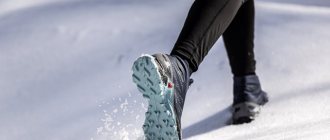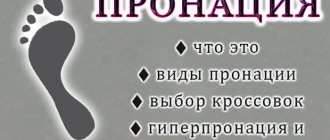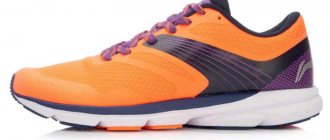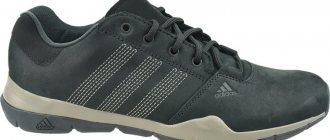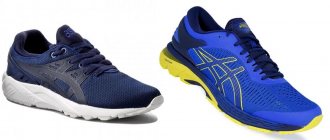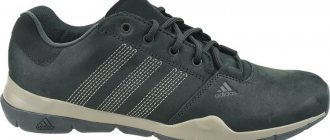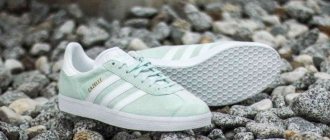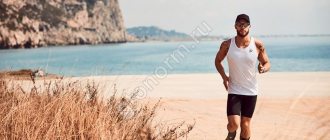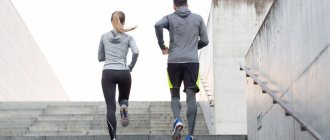A morning jog is a guarantee of a good mood for the whole day and an excellent prevention of excess weight. However, many are forced to abandon this ritual due to injuries: toes, nail plates, heels, arches, ankles, etc. In 90% of such cases, incorrectly selected shoes are to blame. If you also wear it to tennis, fitness, and basketball (and for girls, even on dates), this is a doubly wrong approach. It's time to figure out how to choose running shoes so that they are comfortable and as functional as possible.
The difference between running models and regular models
Running shoes have some design and functional features that set them apart from other types of shoes.
- Increased shock absorption, which is provided by special inserts or an additional layer of sole.
- Good elasticity. This is especially true for the front part of the product.
- Resistance to mechanical abrasion. There are special inserts in the sole of running shoes in areas of maximum load.
- Increased rigidity of the heel area, which ensures reliable fixation of the foot.
- Air-permeable material.
- Lacing is required.
A characteristic feature of good running shoes is that they are lightweight. You need to select such shoes strictly individually.
The presence of lacing and resistance to mechanical abrasion
Increased rigidity and shock absorption
Good elasticity and ventilation
Detailed inspection - attention to detail
We check the presence of an instep support. It protects the ankle joint from premature fatigue. The instep support also provides the necessary prevention of the development of all kinds of problems with the foot and the musculoskeletal system of the body as a whole.
Please note that there is a removable insole inside. It will keep your sneakers in proper hygienic condition, eliminating unpleasant odors. The removable insole can be dried and, if desired or necessary, replaced with an orthopedic analogue.
Check for a soft edge in the ankle area. It will minimize the possibility of chafing and avoid other discomfort during use.
With a quick visual inspection, you are convinced that the glue is applied evenly and neatly, but it is still worth noting that it may move slightly due to temperature changes. So the best option is to choose sneakers that are both glued and stitched at the same time.
Don’t be lazy, especially carefully, even scrupulously, study the material from which the shoes are made. Of course, high-quality leather sneakers for active pastime or sports activities are an excellent choice. But models made of artificial leather are a dubious pleasure, or rather sheer problems: legs do not breathe, low shock absorption, inability to withstand loads, discomfort, etc. When deciding which sneakers to buy, the “leatherette” option shouldn’t even be considered.
On the contrary, models made from progressive high-tech synthetics have proven themselves to be very good sneakers. They are in no way inferior, and sometimes even superior, to their leather counterparts. The innovative material is able to provide excellent air exchange inside the model. When checking the quality of the manufacturing material, to make sure which sneakers are better, you should conduct a small but effective test. You just need to press your index finger on the toe area for five seconds, if the resulting indentations are leveled out immediately, then this model is worthy of your attention.
When choosing comfortable sneakers for every day, you should focus on the sole. The shallow and dense relief will provide the necessary level of comfort. Following the instructions and recommendations on how to choose the right running shoes will help you make the best choice for the perfect model.
Design Features
Running shoes have 2 parts in their design: upper and lower. Each of them is further divided into several more elements.
Sole Unit (bottom)
The sole design consists of 2 parts: inner and outer. They are produced separately from each other, but at the last stage they are glued together. It is important to understand the features of these components in more detail:
- Inner part. It's called Midsole. This fragment is located between the outer part and the insole. Foam is used to make it, which ensures the stability of the shoe and its softness. Most models use polyurethane or ethylene vinyl acetate. However, well-known manufacturers can use their developments.
- Outsole. This is the outer sole that comes into contact with the ground. It is made from carbon or blown rubber. In the first case, the material makes the shoes heavier and stiffer. The second option helps improve the flexibility and shock absorption of the product. To improve technical characteristics, both materials are needed in one pair.
It is important to know what Heel Drop (Offset) is. This is a measurement of the thickness of the sole at the heel of the product - the difference between the height of the heel and toe. This parameter is of great importance, as it plays a role when the foot lands on the surface of the base. The higher this number, the more it promotes heel strike.
Running shoes must have stiffening ribs. The lateral one is located inside the sole. It is made of durable ethylene vinyl acetate and serves to control excessive pronation, stability of shoes during movement under vertical load. Of great importance is the plantar frame, which is located between the plantar part and the insole and runs under the arch of the foot. Its role is to ensure the stability of the sneaker against torsion and bending.
Upper (upper part)
It is made of knitwear, mesh, fabric. Natural or artificial leather is not used in running shoes, as it does not provide the necessary functional features of this type of shoe. This part consists of the following elements:
- Sock. This is where your toes are located, to make running in sneakers comfortable, you need to choose the right width and height.
- Tongue. A separate fragment designed to protect the foot from the pressure of laces.
- Top. That part of the shoe that is made of fabric. Includes the toe box and ends where the lacing is.
- Heel part. It should fit well on the leg.
- Inlay protecting the Achilles tendon.
- Ears. They are required to secure the laces. Their number depends on the type of model. There is often an additional eyelet at the back of the shoe, which ensures that the foot fits well in the shoe.
- Laces.
Another element of the upper is the insole. It provides additional cushioning and also protects the skin from chafing against the seams.
Shoe lasts
To make the best running shoes, manufacturers use the three most common types of lasts:
- Straight. This type is used to create models for athletes with insufficient or excessive pronation. The straight last allows you to control the position of your foot. The support of its arch is more rigid, so the weight of the product is greater.
- Curved. These shoes are characterized by softness, but there are no technologies for supporting the feet. This makes it possible to use the sneakers only in competitions. If used during training, the risk of injury increases.
- Semi-curved. This is a combination of the two previous types that is used in most models.
Not only athletic performance, but also foot safety depends on the right choice of running shoes.
Visual inspection - see to the root
Having chosen and tried on the model you like, you should carefully visually inspect it to ensure that you choose high-quality sneakers. We focus on the following points of visual inspection:
- degree of accuracy in applying glue;
- evenness of the lines on the model;
- availability and quality of lacing;
- absence of a strong odor;
- size data;
- the presence of an information sticker indicating the materials used: for the sole, as well as what the outer and inner parts of the sneakers are made of;
- information about the country of manufacture, indication of the model brand.
If during the inspection at least one information point is missing, then it is better to abandon the chosen model in favor of better quality sneakers. If you successfully pass the superficial “face control”, you should begin a detailed study of sports shoes.
Functional characteristics
To choose good sneakers for asphalt or rough terrain, you need to take into account their characteristics: weight and size, level of cushioning, quality of seams, stiffness. You should also pay attention to the adhesion of the tread to the base, its geometry and height, the presence of ventilation, protection from debris and dirt.
Depreciation
The following types of depreciation can be distinguished by distribution zones:
- only in the heel and toe;
- exclusively in the back of the sneaker;
- all over the sole.
The main task of this function is to compensate for the shock load that occurs during running, as it negatively affects all joints of the body. The minimum level of cushioning is allowed to be used only in cases where the legs are well trained.
Tread
When running outdoors, you need special shoes that have good grip on the surface. It is ensured by the presence of a tread, the height of which varies between 0-1 cm. The following types are distinguished:
- Null. Such a protector is not considered an integral part of the product, but is its technological feature.
- Short. The height is 0.1-0.3 cm. In such shoes you can run on asphalt and other hard surfaces. In areas where there is dirt, it performs poorly: the athlete can slip and fall.
- High (0.4-0.7 cm). These sneakers are best used for running on rough terrain where there is dirt and stones. They provide reliable adhesion to the surface and are also made of a material that is more resistant to wear.
Sneakers with spikes are designed for running on snow and ice. The tread pattern determines how much dirt will clog the sole. This greatly affects the level of adhesion to the base.
Drop
A special feature of running shoes is that the heel is always higher than the toe. This value is usually indicated in its technical specifications. A high rate ensures a smooth transition from heel to toe. If an athlete uses natural running technology or from the toe, then it is better to choose sneakers that have a minimum drop: no more than 0.4 cm. In order not to reduce the shock-absorbing properties, manufacturers make shoes with high soles.
Weight
You can walk, train or compete in running shoes. But here the choice largely depends on the mass of the couple. If the distance is long, then preference is given to heavy shoes. The weight of standard models ranges from 560-800 g (pair). The weight increases in proportion to the size of the products. The weight of competitive pairs of sneakers is 340-560 g. Studded sneakers and products intended for sprinting are no heavier than 500 g.
Toe and heel stiffness
This parameter is determined by the purpose of the shoe. Marathon shoes (competitive running shoes) have virtually no toe rigidity, so it is better not to touch any obstacles with this part of the product. Most models have an average indicator. Road shoes do not need this characteristic at all.
As for heel stiffness, it is important for those athletes who train on rough terrain. In this case, the back of the sneaker should be securely fixed on the foot. She is also required to protect the Achilles tendon. Products used for trail running have a less rigid heel section.
Torsional and lateral stiffness
The first parameter is the torsional rigidity of the shoe sole. The smaller it is, the more a person feels relief changes, small pebbles that come across on the way. If the product is twisted too well, the athlete may suffer injury, sprain, or rupture of tendons. Such models should not be used by poorly trained people. The higher this indicator, the better, since in this case the runner’s safety and leg stability are ensured.
Lateral stiffness is the degree to which a shoe flexes at the sole. The smaller it is, the higher the pushing ability of the ankle. Some models with increased performance have special stabilization and propulsion systems, which reduce the load, but this is not always the case.
Foot girth and fixation
It is determined by the features of the cut of the upper part in combination with lacing. The foot should be well fixed. But you don’t need to squeeze it too hard, as blood circulation is disrupted. The skin will chafe and air exchange will deteriorate.
Lacing
One of the most important elements designed to securely fix shoes on the foot. There are several types of lacing. The main ones include the following: classic (softer and easier to loosen), with regular knots, high-speed (here it’s enough just to tighten it, which is especially important in winter).
Ventilation
When choosing the best running shoes, you need to pay attention to those models that provide good air exchange. The main function of ventilation is to remove excess heat from inside the shoes so that your feet do not sweat. It only works well if you also use special running socks. Shoes with a membrane are less ventilated, so you need to choose products with additional ventilation inserts. They are usually present on the sides, but are sometimes found on the plantar part.
Dirt protection and heat protection
Models with a membrane are well protected from dirt, water and snow. They also have enhanced thermal and wind protection. Textile products do not have such advantages, but they dry faster and are better ventilated. Some models have additional protective membranes at the top.
Other important properties
When choosing running shoes for heavy runners, you need to consider the width of the last. There should be enough room in the front to allow you to move your fingers. The strength and durability of shoes depends on the quality and type of seams, as well as the type of connection of all parts. Damage to sneakers most often occurs in places of anatomical folds.
Workout
Returning from point 1, we can say with absolute certainty that people do not have the same motivation to “just run.” People run in order to achieve a specific goal, which is 100% measured in objective numbers:
- lose 10 kg by summer (up to 1.06);
- achieve certain physiological indicators by the beginning of the running season (by April 1);
- run a marathon in September under 4 hours;
- run up to 1.05 10 km without stopping;
- run your first, long (> 20 km) trail before the end of August (before 1.09);
Well, since there are specific goals, then to achieve it it is necessary to build a “plan”. This should be a schedule of your training, compiled based on your goals, current physical shape, and possibilities for the number of classes during the training period.
Training plans will protect you from undertraining, when due to lack of time or motivation you do not have time to get in sufficient shape to achieve your goal, as well as from such an extremely unpleasant condition as overtraining. The second state is especially typical for beginners who want to see the result of their efforts as soon as possible, “here and now” and begin to “burn kilometers and seconds” without giving the body the opportunity to fully recover. If you are a complete beginner, you should start running with an active, long walk so that your body gets used to the load. A gradual, gentle increase in physical activity is the cornerstone of ensuring that you get pleasure from running, and not irritation and fatigue. Good physical shape is ensured by developed muscles and a trained cardiovascular system, which cannot change dramatically - just as a large tree cannot grow in one day.
The “golden” rule, which is recommended by professional running coaches, is to add no more than 10% of your volume in kilometers from month to month. Forcing an outcome can lead to injury or burnout.
Ideal scenario
Training with a professional trainer, in a group or individually according to a personal plan. A personal plan is drawn up for you by a trainer; it adapts and changes depending on your condition and capabilities. For example, if you get sick or need to go on a business trip where you won’t be able to train, then the plan will need to be adjusted to take into account the time lost due to illness or work. The coach will load you not only with running volumes, but also with general physical training and special running exercises.
Tolerable scenario
Training with running clubs or running schools. Most often, well-trained, professional trainers with very extensive running experience work there. There is no talk about an individual training plan, but the “advantages” are that such training is regular, systematic, organized, and takes place in the company of motivated people. If you love parties and live human communication with people who have similar life values, then choose this option - in a running club or running school you will definitely be on the same wavelength with the same running enthusiasts.
Brands or retail stores periodically organize special training cycles at their base. Most often, such cycles are free; by participating in them, you can save on the purchase of equipment using special discount programs for participants. The advantages of such cycles are that they are most often free, the disadvantages are that such training is tied to certain “points” - retail stores that are not suitable for organizing the training process - they do not have sufficient infrastructure: equipped locker rooms, showers, etc. P. In addition, the cycles of “free” training are not always predictable in time, the initial state is rarely taken into account, and the physical fitness of those wishing to train is not tested.
Bad script
Training according to plans compiled by fitness applications. Definitely not suitable for beginners. Applications create training plans based on a certain average training plan that was implemented by other participants with similar physical data. The apps don't take into account changes in your schedule or your current emotional state. The good thing about apps is that the form in which your workout data is collected is very convenient. It can be used by both you and your coach, who can use the application as a form of objective monitoring of the training process and progress.
Classification
To select the right running shoes, you need to consider their types. Products can be classified according to the following parameters: the type of surface on which the athlete will train, the type of pronation, running technique, and intended purpose. The choice of shoes also depends on whether men's or women's sneakers are needed.
Special purpose
Selecting sneakers requires a competent approach. It is necessary to understand what they will be used for. There are 2 main groups here:
- Trainers. Training sneakers for constant jogging on dry ground or asphalt. They provide support and safety for the foot and are designed for long distances.
- Competitive. They are as light as possible and are not equipped with leg stabilization technologies. Such products place the greatest load on the supporting apparatus. They are designed for short, fast runs in competitions.
Minimalistic sneakers are also made, which are better for trained athletes to run in, as the foot moves naturally in them.
Competitive Trainers
Coverage type
To choose the right running shoes, you need to decide where exactly you will be training. According to this parameter, shoes can be divided into the following groups:
- Highway. These are products with maximum shock absorption, so that it is possible to absorb the shock load when landing on the foot. Their upper part is softer.
- Trail. The sneakers are designed for running on rough terrain. They are equipped with a tread on the sole that improves grip on the ground. The upper part of the product is made of more durable material, and in places of maximum load there are additional inserts. The back here is more rigid.
- For use in the hall. For example, for shuttle running. These sneakers have a durable sole that should not slip or spring.
- For the treadmill. Here you should give preference to the best running shoes for running on asphalt. They must have good shock absorption.
Properly chosen sports shoes will help avoid foot injuries.
For treadmill
For the hall
Trail
Road
Seasonality
Summer products are made from lightweight materials. Silicone or foam is used for the sole. Mesh is used for the upper, which allows the legs to “breathe”. A pair of these sneakers has minimal weight. You can wear them not only on the street, but also in the gym.
For winter time, sports shoes made of denser materials with additional insulation are required. A membrane is often used for the upper, and the weight of a pair is up to 800 g. The sole is made of polystyrene and is thicker. A winter option is studded sneakers, in which you can run on icy roads without the risk of falling.
In demi-season models you can train in autumn and spring. They are protected from moisture. In these sneakers they train in the rain and run in the dew. The products contain the necessary ventilation inserts.
Winter
Summer
Pronation type
Pronation in running shoes is the part of your foot movement that helps distribute the force of impact on the ground. There are these types:
| View | Shoe selection |
| Neutral | The load on the foot is distributed evenly, and it can fall inward by no more than 15%. In this case, any soft shoes are suitable. |
| Overpronation | It is an excessive roll of the foot inward or flattening. The longitudinal arch decreases. The ligaments are constantly under tension, and the shock-absorbing properties of the limb are reduced. In this case, additional insoles must be inserted into the sneakers, and they themselves must stabilize the foot. Maximum medial support is needed. |
| Underpronation | Insufficient arch of the foot. The collapse of the leg occurs on the outer part. This requires neutral running shoes with enhanced cushioning, which promotes proper load redistribution. |
You can determine what kind of pronation an athlete has by consulting an orthopedist.
Running technique
When choosing running shoes, it is important to take into account exactly how a person runs and what sports he prefers. There are only three techniques:
- Classic. It is characterized by heel support. In this case, the entire musculoskeletal system becomes tense. To reduce the level of stress, you need to choose sneakers with a heel that is thicker than the front half.
- Natural. The main load falls on the middle part of the foot. You will need sports shoes in which the sole has a uniform thickness and the treads are in the middle part.
- Sprint. The support is on the toe. In this case, you need special sneakers with shock absorption in the front part.
For competitions and training, it is better to purchase different pairs of shoes.
Gender of the athlete
To choose the best running shoes, an important parameter is the gender of the person. Women's models have the following features:
- narrower block;
- extra heel height;
- softer shock absorption due to lower body weight.
Competition running shoes have the same properties for women and men.
Women's
Men's
Beginner Formula: Cushioning Plus Stability
The formula “The longer a runner's distance, the lighter the shoe, the more cushioning and stability” does not always work. It all depends on the athlete’s preparedness. A beginner needs stabilization and cushioning for his first marathon; a professional needs a neutral sneaker with minimal cushioning - he runs fast and wants to get a good rebound of the shoe so he can spend less energy.
shutterstock.com
There is an example of a universal model - Nike Pegasus. World champions train in this model. They have average cushioning, are lightweight and have good breathable mesh, but lack arch support. Suitable for athletes who have been training for a long time - when the ankle is ready for stress, they can be used to run quickly over long distances.
For beginners, the Asics Gel Kayano model is suitable. It is quite light, has foot support, and a plastic cup for stabilization. Suitable for long training sessions and short accelerations.
How to choose the right size
It is better to purchase a product that is 1-1.5 sizes larger than shoes that are used for walking every day. This way you can protect your fingers from injuries and calluses. The width of the last varies, so the product must be measured laced and unlaced.
This procedure should be carried out at the end of the day, when the foot is slightly flattened and increased in volume. The upper part of the shoe should fit your foot tightly without causing any discomfort. Sneakers that are too large will result in the athlete being unable to run: they will fall off the feet.
Selection criteria and common mistakes
To choose the right professional sneakers, you need to consider the following criteria:
- compliance in size and degree of depreciation;
- place of running and purpose of using shoes;
- setting and other anatomical features of the foot;
- good level of flexibility of the sole in its forefoot;
- use of “breathable” materials when sewing;
- placement of lacing in the center of the product;
- the presence of a removable insole.
Not every lover of a healthy lifestyle can choose the right running shoes. The most common mistakes:
- weak fixation of the heel, as a result of which it “walks”;
- resting the finger on the toe (leads to injury, chafing);
- excessively tight fixation;
- use of socks not intended for running;
- lack of ventilation in shoes;
- bad fitting of sneakers.
Failure to follow these selection rules can result in injury or problems with the skin of your legs.
Brand
Oddly enough, the brand of shoes is also important. More precisely, you need to find yours. Each running brand has a specific fit and features. You need to find one that produces running shoes that best suit your running biomechanics and foot characteristics.
For example, Asics, adidas and Salomon S/Lab traditionally have a fairly narrow last. If you have wide feet, then take a closer look at Saucony and Mizuno. And it’s not just the last: the top, the sole, the drop, and much more matter. For example, Hoka has bulky soles: some people need to get used to them, but others don’t want to get used to them.
So before buying, be sure to try on shoes from different manufacturers, be sure to test them in the store: if there are treadmills, stairs or test slides, be sure to use them.
The best manufacturers and models
To choose the best running shoes, it doesn’t hurt to consider the manufacturers of sports shoes and their characteristics. The following well-known brands can be distinguished: Adidas, Asics, Nike, Mizuno and others.
Asics
A Japanese company that produces a variety of sports shoes. The advantage is the use of “breathable” materials, the light weight of the pair, and an affordable price (from 3,500 rubles). All products contain a gel-like substance in the sole that improves shock absorption. Shoes are used for short and long distance running. When choosing, you need to be careful with the size.
Mizuno
A Japanese brand that is characterized by careful consideration of the anatomy of shoes, as well as the production of sneakers for various purposes. In addition to increased shock absorption, such products have a special clip in the back that secures the heel. The sneakers are characterized by good ventilation and increased service life. There is a choice of shoes for feet with different types of pronation and flat feet. The cost of a pair starts from 3,500 rubles, but may be overpriced.
Adidas
A German manufacturer, which in most models uses innovative foam that provides high-quality shock absorption. The products are distinguished by increased strength, good fixation of the foot, low weight, and comfortable lacing. The line of sports shoes includes special high-speed models. They can also be used in winter or rainy weather. There are separate models of sneakers for running on asphalt. The cost of a pair is 3400-20000 rubles. Disadvantage: The sole may slip a little at the heel.
Nike
An American manufacturer that produces not only functional, but also visually attractive shoes. The upper part is made of a special lightweight fabric that provides good air exchange. There are no multi-layer adhesive pads. The advantage is the single seamless design of the product, thanks to which the fit of the leg is as comfortable as possible. The cost of a pair is from 4500 rubles. But most models have thin soles, so they should not be used by athletes with large body mass.
Salomon
A French company characterized by the high reliability of its shoes, wear resistance, and comfort. The models of this company are ergonomic, have protection against dirt, so they can be used in any natural conditions. The sneakers are light in weight and fit well on the foot. But their cost is quite high, about 7,500 rubles per pair.
Hoka
French sports shoes with excellent shock absorption, so they can be used for long distance running. It is characterized by a thick sole, while the weight does not increase. This company produces products for various purposes.
Depending on the purpose of the models, we can present the following rating of the best sneakers:
| Name (type) | Characteristic |
| Adidas Energy Boost ESM (long distance running) | They have a high rise, bend well in the sole, and have a durable heel that provides reliable fixation of the heel. The foot practically does not feel the unevenness of the base. But they are expensive, and the soles are difficult to clean. |
| Asics Gel-DS Treiner 20NC (for everyday training) | The sneakers are lightweight, well ventilated, and prevent microtrauma. The foot is securely fixed. The models also have a beautiful appearance. The disadvantage is reduced flexibility and high cost. Also the shoes are not designed for long distances |
| Mizuno Wave Paradox 2 (running shoe model for flat feet) | Well suited for use with different types of pronation. But they can only be used in good weather. |
The choice of running shoes also depends on whether a person is a professional runner or just wants to keep fit.
Adidas Energy Boost ESM
Asics Gel-DS Treiner 20NC
Mizuno Wave Paradox 2
History of running shoes
The prototype of modern running shoes appeared in the 18th century in Great Britain. These were shoes made entirely of leather. Unfortunately, they stretched quickly and also got wet in the rain. In 1832, the British Waite Webster was granted a patent for a technology that made it possible to equip leather boots and shoes with rubber soles. Another 20 years later, his compatriot Joseph William Foster, founder of the Reebok brand, came up with the idea of adding spikes to the rubber sole.
In the second half of the 19th century, shoe manufacturers mastered the technology of vulcanization, that is, fusing rubber and fabric together. This mixture was molded to create a shoe sole with a tread pattern. The shoes became flexible, light and silent.
In 1892, the first ever pair of sneakers (Keds) was released: this model had a rubber sole and a canvas upper. It was manufactured by Goodyear. Sneakers began to be advertised as sports shoes only in 1917. Then consumers came up with another name for them - “Snickers”. This word comes from the English verb “to sneak,” which means “to sneak around.”
In 1920, German Adolf Dassler, the founder of adidas, was the first to produce specialized running shoes. They were equipped with hand-forged spikes, and each running distance had a different model design.
First adidas running shoes
The first sneaker model to be scientifically tested before going on sale was released by New Balance in 1962.
Useful tips
To make using sneakers comfortable and running safe, you need to use the following recommendations:
- Wear special socks for running, as they promote good ventilation.
- Be careful when purchasing shoes without examining and trying them on to avoid counterfeiting or making a mistake with the size.
- Shoes should be changed after traveling 600-1200 km, even if the sneakers seem suitable in appearance.
- Products are washed once a month.
Running shoes are high-tech shoes that need to be chosen taking into account many factors. The wrong pair can cause serious harm.
Use special running socks
Shoes should be changed after traveling 600-1200 km
Do not buy without inspection and fitting
Introduction.
Most often, when choosing new sneakers in a store, your feet will feel quite comfortable in them, but in fact, the real test for your sports shoes will begin only after you have trained in them and run a couple of kilometers. That's when you'll realize that the perfect running shoe has more to do with your specific athletic goal, your running style, and the shape of your foot, rather than a pretty logo.
In most cases, from the point of view of shock-absorbing properties, one pair of sneakers is enough for about 600-1000 km of running, or six months for the average runner. Look at your shoes and check for compression or wear in the heel of your sneaker. If cracks, creases, etc. appear, then you should think about replacing sports shoes.
